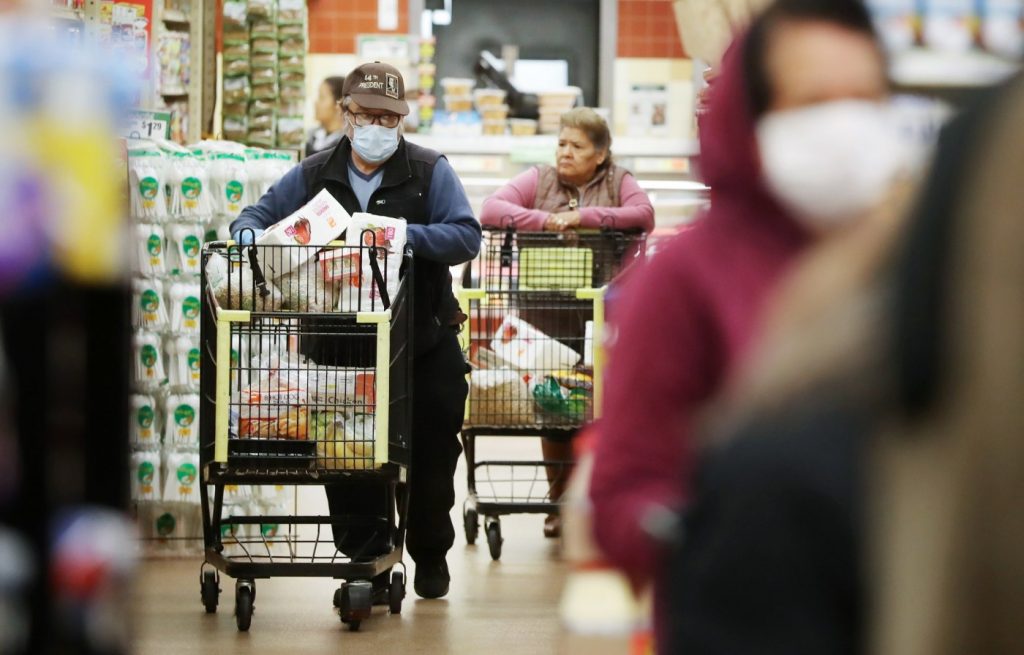By Anna Helhoski | NerdWallet
Four years ago, in February 2020, the economy plunged into a recession as the pandemic began to take hold. What followed was one of the fastest economic comebacks in modern history.
Today, the economy is booming, marked by high growth, persistently low unemployment, rising wages, high consumer spending and slowing price increases.
Still, the virus killed over 1.17 million people in the U.S. alone. The emergency is over, but COVID remains with us.
But it’s undeniable that the massive stimulus in response to the pandemic emergency is what prompted that quick economic rebound, says Scott Fulford, senior economist at the Consumer Financial Protection Bureau (CFPB). NerdWallet spoke with Fulford on how he explored this cause and effect in his book “The Pandemic Paradox.”
The following interview has been edited and condensed for length and clarity. Fulford speaks on behalf of himself and not as a representative of the CFPB.
Before and after
NerdWallet: In broad strokes, what is the pandemic paradox?
Scott Fulford: Let’s step back to March 2020. That was a really scary time for lots of people for lots of reasons. There was a new virus going around and we really didn’t understand how severe it was. Then, as people started staying home and a shutdown occurred, something like 22 million people lost their jobs. It really looked like there was this financial apocalypse that’s about to come.
The paradox is that by June 2020 and then for the next two years, people were actually better off financially than they had been before the pandemic on just about every measure you could look at. To be clear, on average there were some people who were worse off, but most people were just generally better off.
That’s a huge surprise for anyone coming out of the 2008 financial crisis and the Great Recession. The idea that something that deep could cause people’s finances to improve was a big surprise.
NerdWallet: Let’s go back to February 2020: What was defining the economy right before it fell off that cliff?
Scott Fulford: The country actually had been growing and employment had been increasing for nearly 10 years. Throughout 2019 and early 2020, people were looking around and thinking, “This is a really good economy.”
Employment rates had only just gotten to the point where they had been in 2007 — especially for Black workers. In many ways, it took us a full decade to get back to where we were since before the Great Recession. So it was a good economy in some ways, but it was also an economy that had a lot of risk. There was a lot of financial insecurity in February 2020. The pandemic paradox was so surprising to me because I saw all of the fragility among many households.
The pandemic, in some ways, shows us what we can do if we change the way we think about the economy and change policy. That doesn’t mean policy changes solve all problems. But what did get better was because there were a lot of dollars spent and because people were radically changing their lifestyle.
I want to acknowledge that that doesn’t mean that the pandemic was a good thing — a lot of people died.
NerdWallet: What comes to mind to me when you talk about fragility is housing affordability, particularly rental housing. You said in your book that the pandemic could have also exacerbated existing structural problems for renters. How so?
Scott Fulford: One of the things that the pandemic did illustrate was the importance of thinking about housing and housing affordability. To break that down a little bit: For the average household, housing amounts to like 30% to 40% of its budget. What that means is that, for most people, the largest thing that they spend on is housing. For many lower-income households, it’s a lot more than that. So all the other decisions we make are kind of downstream of the cost of housing.
Housing has just gotten more and more expensive, and a lot of that is because we used to be able to build a lot where people wanted to live, and that’s become more and more difficult. In urban areas, the only less expensive housing is further and further away from city centers, which means you’re sort of prioritizing access to good jobs versus the ability to afford housing.
Recovery and inequality
NerdWallet: What are some of the ways that the most vulnerable groups were immediately impacted by the pandemic, and what were some of the longer-term impacts? For example, you said in your book that the racial wealth gap didn’t expand during the pandemic, but it also didn’t really shrink either.
Scott Fulford: The initial one is that lots of people lost their jobs and it really did look like particularly Black and Hispanic unemployment was spiking much more. The good news is that there was a great recovery in Black and Hispanic unemployment; it went back down approximately as rapidly. So it ended up being not a really unequal recovery. That doesn’t mean it couldn’t have been more equal, but less unequal than before is still a really good thing, right?
Related Articles
Jill On Money: January jobs jump
How to book a unique all-inclusive vacation that’s not terrible
6 ideas for saving money on Valentine’s Day
The 4 longevity questions you should ask your financial planner
Romance scammers: They call you honey, but don’t send them money
The longer-term things are somewhat troubling. We had a severe learning loss and those seem to be particularly concentrated among the least advantaged students.
I’ll use an example: My wife and I could mostly work from home. So when our kids were doing Zoom school at home we were there to supervise. It was not fun, but we were able to provide for them because we had the privilege of working from home.
That same experience didn’t happen for lots of kids. Their parents maybe had to report to work in person and so weren’t able to supervise. When schools were closed, the learning gaps that already existed just got exacerbated. Effectively, many students just lost six months to a year of school — that’s a pretty substantial amount of lost education and over time, probably, lost earnings.
NerdWallet: To that end, the pandemic also showed how child care plays such a crucial part in our social and our economic lives. The pandemic seemed to expose a lot of those vulnerabilities.
Scott Fulford: We learned that if you don’t have child care, you can’t work, right? So child care really ends up being sort of central to the ability of parents to be able to go to work and parent, and that’s central to the economy to be able to function well.
We did see this as things started to open up, parents really did want to go back to work, but they all couldn’t. Because the thing about going back to work meant that they needed to have somebody taking care of their children, and child care centers were not always open. It’s a difficult industry to operate in. And I think it’s hard to figure out exactly how to make child care part of the way in which all parents, particularly women, can work.
NerdWallet: That was the so-called “she-cession,” right? Mothers were more likely to stay home for the kids if the availability of child care wasn’t there. Or due to the cost of child care, it was more financially viable to stay home.
Scott Fulford: There’s something really exciting that the pandemic did change that allows for greater flexibility. The rise of remote work has been largely responsible for many women with children being able to go back to work.
It’s turned out that women have been a really important share of what is, overall, a very high employment rate. I think a lot of that is simply more flexibility and the rise of being able to be home at least part of the time. It suggests that we may see long-term improvements in things like the gender wage gap if women don’t have to be out of the workforce when they have children.
NerdWallet: Obviously many jobs cannot be performed remotely. But it seems the pandemic created the opportunity for more flexibility for office workers, for example. Does it seem like remote work is here to stay at this stage of the game?
Scott Fulford: I think it’s too soon to say, but I do think remote work and hybrid work are not going to go away. There are, as you say, many jobs that just have to be done in person. But there are jobs that can be done remotely and can be done really effectively, remotely, almost all the time.
Working out that balance between what’s good for employees and what’s going to work for employers is going to be something that I think is going to be a continuing tug of war.
NerdWallet: It seems like without the technology that made remote work possible when the pandemic started, the unemployment rate could have been worse. But unemployment was very high and that situation exposed how ill-equipped some state systems were to handle it. Can you explain?
Scott Fulford: The first thing to understand about unemployment benefits is that they’re a joint federal and state program. And that’s exactly as complicated as it sounds. That means that all 50 states plus D.C. and Puerto Rico and the territories are doing their own thing, but they’ve got a federal government kind of in the mix.
The pandemic, with so many people suddenly becoming unemployed, exposed the differences between the states: Some states just had good systems and others states’ systems simply broke. Part of the reason why all this matters so much is that the federal government expanded unemployment benefits substantially in response to the pandemic.
The CARES Act added a really substantial amount that was, in some ways, almost an unfair amount of money. By that I mean that many unemployed people were earning more than they had when they were employed. And many essential workers would have felt better off if they were unemployed because they would have been earning more and wouldn’t have been exposed to risk.
Stimulus and savings
NerdWallet: Since you mentioned it, let’s talk about the CARES Act, especially the stimulus checks and how financial well-being was able to improve in such a short period of time.
Scott Fulford: There are two different pieces that are going on. First, one thing that was contributing to an overall better financial situation was that lots and lots of families were not spending very much.
Part of financial well-being is that lots of people were just saving much more than they had been before. Of course, the cost of that was they weren’t going out to see their friends and they weren’t going to bars and restaurants.
The second piece was the government stimulus. The unemployment benefits were there to mostly catch people who were not doing well. Then, very early on, the CARES Act sent out fairly large checks to most Americans. So it sort of propped everything up.
In a general sense, incomes were kind of kept the same or even went up and people were spending less. And those two things together meant that lots of people had more savings and were having less financial problems.
NerdWallet: We bounced back so quickly from that very brief 2020 recession when consumer spending had reduced dramatically and savings went up. Now, the scales have tipped somewhat. Can you talk a little bit about inflation and how that kind of came to be?
Scott Fulford: Inflation was actually not as complicated as we thought it was. A lot of people wanted to buy things — some of that was contributed by stimulus, but most of it was just those savings that people ended up not spending. And then wanted to do things like go on revenge travel, so suddenly your tickets were more expensive.
There were just a bunch of supply-demand mismatches, and the way that a market economy fixes a supply-and-demand mismatch is by adjusting prices. Eventually, those things have come back into balance.
I don’t think we are going to have deflation where prices, on average, go down. And I think that’s a very good thing even though it’s not obvious that it’s a good thing. Deflation is typically a depression thing; it usually means the economy is really terrible. Even though we all hate high prices, what we actually don’t want, in a macroeconomic sense, is to have deflation.
NerdWallet: Despite higher prices, this economy is robust: The GDP was higher than anticipated all year long, people are still spending and unemployment is really low. Does it seem like we wouldn’t be in this particular situation had we not had the pandemic?
Scott Fulford: We are now back to where we would have been had the economy just continued the trend for the previous 10 years, and that’s amazing. It’s a really stunning thing because the economy never got back to where it was before 2007. We were just about 10% poorer because of the Great Recession.
I think a lot of that has to go down to policy. A lot of the economy over the last several years has just come down to consumers having money to spend and not being financially fragile.
More From NerdWallet
When Will the Fed Cut Rates? More Data Needed, Powell Says
The Current Inflation Rate is 3.4%. Here’s Why It Matters
Are We in a Recession?
The article Economist: How a Global Pandemic Made Us Richer Four Years Later originally appeared on NerdWallet.


